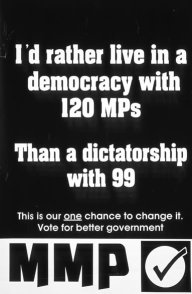Electoral reform in New Zealand
Proportional representation led to an increase in minor parties entering Parliament, making multi-party governments the norm.[3] If no one reached this threshold in the first count, a new round of voting was conducted featuring only the two highest polling candidates, this ensured one or the other gains over 50%.This was discontinued in 1913, NZ reverting to FPP in single-member districts, the successful candidate winning by plurality, which in many cases was less than half the votes.Prominent examples of this include the 1966[8] election, in which the Social Credit Party gained 9% of the vote and yet won only a single seat.Though the Judiciary ruled this move illegal, they were unable to halt the action and Muldoon faced no repercussions for this abuse of power.The results of this referendum overwhelmingly supported change and selected MMP as the preferred electoral system to replace FPP.[14] This Act established settler self-government in New Zealand by the way of a bi-cameral Parliament consisting of an appointed Legislative Council and a House of Representatives.[20] Universal male suffrage was introduced in 1879 by the passing of the Qualification of Electors Act, which abolished the previous requirement to own land.The second-ballot system was introduced in the Second Ballot Act 1908 and was one of the first substantive reforms to the mechanism by which winning candidates are elected to Parliament to be seen in New Zealand.However, this system only remained in place for five years as it was abolished in 1913 due to its supposed inequitable nature in the emerging party environment of Parliament.[25] In its 1984 campaign platform, the Labour party committed itself to appoint a royal commission on electoral reform if elected.[10] Recognising that a parliament dominated by the major parties might fail to implement a sweeping reform of this sort, the commission also proposed a referendum on the issue.Meanwhile, the Electoral Reform Coalition campaigned actively in favour of the MMP alternative originally recommended by the royal commission.Voters could choose between the following (as listed on the ballot): As noted earlier, an overwhelming majority of those favouring a new electoral system voted for MMP.[31] The Electoral Reform Coalition (ERC) was the main advocate for the adoption of MMP, and had support from several people, including the Green Party co-leader Rod Donald.MMP faced an uphill battle, as acknowledged in the pro-MMP poster to the side, since the proposed model was for increase in the number of MPs from 99 to 120.While the CBG could spend large on television, radio and full-page newspaper advertisements, often with fear-evoking graphic images, the ERC had limited funds and concentrated more on advocating in communities.[33] At the same time, the country's largest newspaper, The New Zealand Herald, came out in support of the MMP proposal in the last week of the campaign, and press coverage overall was extensive and largely favourable.[...] Politicians subsequently acquiesced as they lost control of the referendum process because to have done otherwise would have courted the full wrath of a public incensed by their own impotence in the face of years of broken promises.Look at the people who are telling you not to..."[37] Given the link between the success of the referendum and anger at the status quo, politicians took lesser roles in the 1993 campaign, realising that their opposition to reform only increased voters' desire for change.[34] In the face of a strong opposition campaign, the final result was much closer than in 1992, but the reforms carried the day, with 53.9% of voters in favour of MMP.Source: Nohlen et al. Noteworthy in understanding the New Zealand case is that the reforms were able to go forward on the basis of majority support.This stands in contrast to the 60% requirement imposed in some other cases, such as the 2005 referendum on this issue in the Canadian province of British Columbia that failed despite a vote of 57.69% in support of the reform.Late in the campaign, Peter Shirtcliffe had in fact sought to act on this and proposed that the referendum should require a majority of the whole electorate, not just those voting, to pass the reform, which the government rejected.Supporters of MMP criticised FPP for creating elective dictatorships, and promoting the excessive power of one party government.Furthermore, MMP is considered to increase the representation of a diverse population, enabling a higher percentage of Maori, women, Pasifika and Asian people in Parliament.This could be attributed to political scandals[44] and the popularity of the Labour leader candidate, Jacinda Ardern, and evidence of the beginning of an overall decline.Upon gaining power, the party legislated that the referendum would be held alongside the 2011 general election, which took place on Saturday 26 November 2011.[53] In response to generally declining voter turnout, a number of commentators have proposed changes to the electoral system.[55] Palmer has also expressed support for lowering the voting age to 16, considering that this may provide a platform for increased civic education during high school years.

Keep
Change
Politics of New ZealandConstitutionThe CrownMonarchCharles IIIGovernor-GeneralCindy KiroRealm of New ZealandExecutive GovernmentList of governmentscurrentCabinetMinistersPrime MinisterChristopher LuxonExecutive CouncilState services departmentsLegislature54th New Zealand ParliamentKing-in-ParliamentHouse of RepresentativesSpeakerGerry BrownleeOfficial OppositionElectionsPolitical partiesElectoratesElectoral systemElectoral CommissionReferendumsPolitical funding and election expensesJudiciarySupreme CourtChief JusticeHelen WinkelmannCourt of AppealChristine FrenchHigh CourtDistrict CourtEmploymentEnvironmentMāori LandWaitangi TribunalLaw of New ZealandLocal governmentRegionsTerritorial authoritiesMayorsCommunity boardsForeign relationsMinistry of Foreign Affairs and TradeMinisterWinston PetersDiplomatic missions ofin New ZealandNationality lawPassportVisa requirementsVisa policyNew Zealand and the United NationsAnarchismChristianConservatismEnvironmentalismFascismFeminismLiberalismPopulismRepublicanismSocialismPolitical history of New ZealandHistory of voting in New ZealandMāori politicsNuclear-free zoneparliamentaryelectoral systemsmixed-member proportionalmultiple non-transferable voteblock votingfirst-past-the-posttwo-round system1908 election1911 election1993 electoral reform referendumproportional representationlist MPs2011 referendumfirst-past-the-post votingabsolute majority1905 electionsingle-member districtssecond-ballotMixed-member proportional (MMP)disproportionalitySocial Credit PartyLabour PartyNational PartyRobert Muldoonelectoral reformRoyal Commission on the Electoral SystemTe Tiriti o WaitangiNew Zealand Constitution Act 1852bi-cameral ParliamentUniversal male suffrageKate Shepparduniversal women's suffrageSecond Ballot Act 1908runoff votingNew Zealand electionsLiberalReformLabourtwo party systemNationalGeoffrey PalmerElectoral Reform Coalition1987 electionJohn TerrisLabour’sJim BolgerproportionalgovernmentTurnoutMixed Member ProportionalGermanyadditional member" system